If your interested in knowing more about kefir and their health benefits I'll leave that up to the experts...
- Patty Donovan wrote "Grow Your Own Probiotics, Part 1: Kefir" back in 2008. Awesome article.
- Dominic Anfiteatro has a webpage with an overload of info. I love that he lists different probiotic strains, yeast strains, recipes, and much more.
- One more website has awesome recipes and further info on how to's.
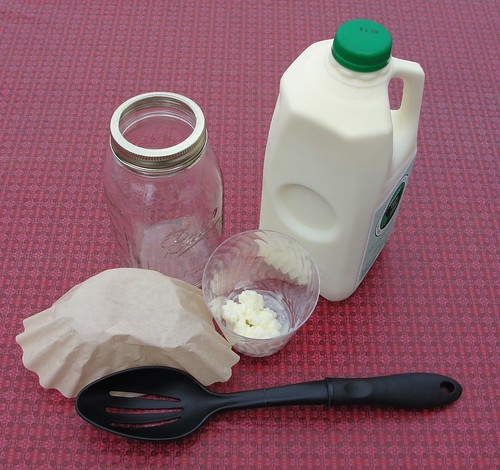
This is everything you'll need for making kefir. Mason jars and some type of cloth or napkin (I use coffee filters) are perfect but you can use any glass or plastic container. Some folks say there is a risk in killing the kefir grains if you use metal so I stick with glass and plastic when messing with this stuff to be safe.
SOURCE: You can either get grains from a friend who has some, or you can order them online. You can't buy the real thing in the store though. You CAN get a starter pack in the store, but they will die after a handful of uses and from what I understand don't have all the nutritional benefits and vitamins that the real grains have. So however you get your Real grains, they will either come ready to go or dehydrated.
MILK VARIETIES:
- You can use any kind of milk, but if you want your grains to continue to live and produce kefir you have to use milk from a mammal of some kind. Cows, goats.... Whole milk is best, raw milk is even better. I've even used the pasteurized, homogenized milk before but the health benefits go much further with better quality milk.
- You can even culture other types of milk such as soy or coconut milk, but use spare grains for milk that doesn't come from a mammal because the grains will eventually die off in that kind of milk.
(And by spare grains I should add here that the grains tend to double in size about once a week.)
ENVIRONMENTAL TEMPERATURES make a difference in the speed at which they reproduce. The warmer side of room temperature will speed up growth of grains and kefir liquid production, the cooler side of room temperature will slow them down. You can send the extra grains to friends, or double the health benefits by adding them to your smoothies.
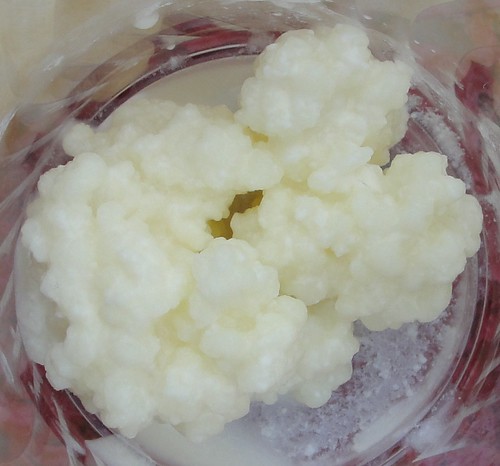
This is what real Hydrated kefir grains look like. If yours are Dehydrated you'll want to continue milk changes daily until they start working. It may take a few days to a week to bounce back after shipping to where it's producing liquid kefir like it should.
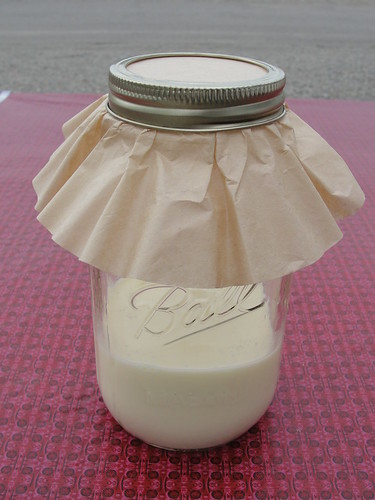
So the first thing you do with your kefir grains is put them into a jar of milk. You'll want to give 1 to 1 & 1/2 cups of milk per tablespoon of kefir grains (I never do exact measurements). You don't want to seal the jar because the yeast fermentation will build up pressure, which is why I use the coffee filter to cover the top of the mason jar. The filter (or napkin) allows it to breath and yet keeps things from falling into the jar. Use milk straight from the fridge (no need to let it warm) and store jar out of direct sunlight for 12 - 24 hours, stirring a few times a day.
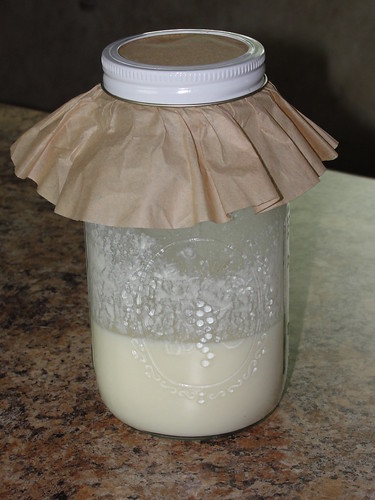
This is what it should look like after 24 hours - I just stirred it. See how it looks above the milk line? That's how it's suppose to look, kinda particlely and grainy. If it isn't stirred it will build up pockets of clear liquid called kefir whey, the white will become extremely thick. It's best to stir it so the grains don't suffocate in the thick stuff. By stirring it, you are helping more lactose to get to the grains, which is what the grains eat and need to survive.
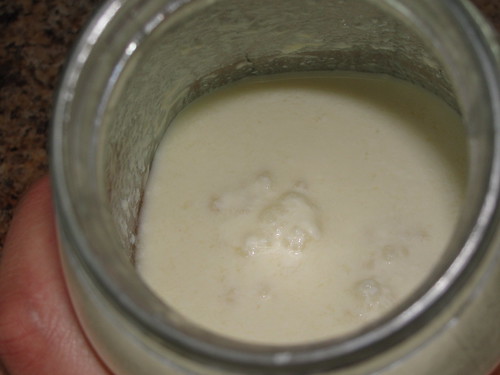
This is another angle of stirred, 24 hour kefir. The big chunks you see are the grains, as they like to float when their at their best. The liquid kefir should look grainy or with tiny chunks after stirring it although it's hard to see here, it will also be rather like the consistency of a melted milkshake - thicker liquid than just milk. If you leave a glass of milk out on the counter for 24 hours it does not look thick and particley like the liquid kefir does, it stays like milk and only shows a milk ring around the glass at the top of the milk line. If your kefir stays like milk after leaving it out, better skip ingesting it until the kefir grains are turning out liquid kefir as they should. It's pretty hard to kill your kefir grains so if they aren't working as they should, just keep changing their milk daily and they will bounce back pretty quickly.
If you are using to much milk your liquid kefir won't turn out thick or as grainy (which is ok if you want thinner consistency).
One last bit of helpful information is how to store your grains when you need a break from producing kefir, or when your going on vacation.
I plan on adding a few more posts with recipes, ways to boost the vitamins and probiotics and hopefully stories of how this stuff can help in specific ways. Just look for posts tagged "Kefir" which you can find by looking in the right hand column under the "Tags" heading.
6 comments:
I can honestly say that this is the first time I've ever heard of kefir! I guess it's true: you learn something new every day!
I had never heard of it about a year and a half ago either. Should you ever decide you want to try it, let me know and I'll send ya some.
Thanks for sharing it.
Could you share with me? I want to see if it helps my GI probs.. was told kefir is good for that. I'd happily send a SASE or pay $. thanks, happy trails, Rick in AZ.
mr_r_bowman@yahoo.com
I AM A DIABETIC TYPE 2 INSULIN DEPENDANT, AND HAVE BEEN TAKING KEFER FOR ABOUT 2 WEEKS AND ALMOST IMMEDIATLY MY BLOOD SUGAR READINGS HAVE DROPPED AND I NEED TO INJECT LESS INSULIN. HAVE NOT DISCUSSED THIS WITH MY DOCTOR BUT WILL IN 3 DAYS TIME WHEN I HAVE AN APPOINTMENT WITH HIM.
Wow, I love that feedback! I had no idea.
Post a Comment